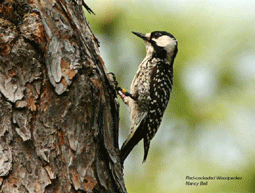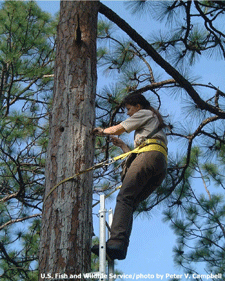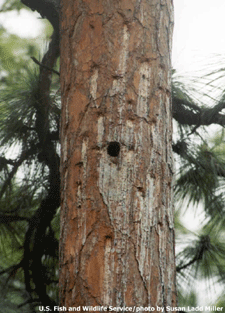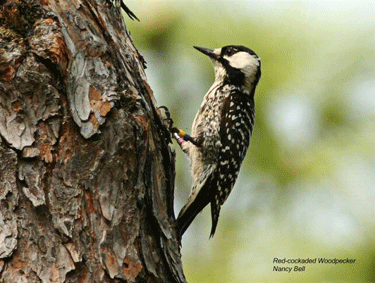A Tune-up for the Endangered Species Act?
Air Date: Week of September 16, 2005

The endangered red-cockaded woodpecker. (U.S. Fish and Wildlife Service photo by Nancy Bell)
One of the Endangered Species Act's harshest critics is leading the Congressional effort to re-write the Act. Living on Earth's Jeff Young explores some of the rhetoric and ideas on changing this landmark law.
Transcript
CURWOOD: Three decades after Congress moved to halt the rapid decline and extinction of animal species with the passage of the Endangered Species Act, Congress is taking another look at protecting biological diversity. Some say the Endangered Species Act is broken and is in need of significant fixes, ranging from new ways to list species to different ways to protect private property rights while managing habitat. Many scientists, lawmakers and landowners all see room for improvement but so far there doesn’t seem to be much common ground in their thinking. Living on Earth’s Jeff Young explores some of the new ideas and old conflicts at work in the latest push to remake this landmark law.
[NIGHT WOODS AND INSECTS]
|
YOUNG: You know the old saw about a bird in the hand. What’s that bird worth when it’s an endangered species?
MILLER: Stay still, sweetheart.
[RUSTLING OF BIRD IN NET]
YOUNG: Biologist Susan Miller gently handles a red-cockaded woodpecker she’s just netted in a North Carolina pine forest.
MILLER: And she’s about to just pop out of this bag.
[RUSTLING]
MILLER: Okay, so she’s got all color bands in place. All that’s left to do is let her go.
[NIGHT WOODS AND WALKING]
YOUNG: The newly banded bird skitters up a long-leaf pine to its nest cavity. Red-cockadeds are the only U.S. woodpeckers to carve their homes in living trees. It takes years. And most of their original forest habitat is gone.
|
Miller is part of the Fish and Wildlife Service’s effort to bring the woodpecker back from the brink of extinction. For the past decade, she’s had some help from some unlikely allies: private landowners.
[TRUCK DOOR SHUTS]
VOICES: Good morning. Good morning.
MALE: Have you seen any red-cockadeds recently?
YOUNG: Miller and a colleague visit Julian Johnson at his home on property where Johnsons have lived for four generations. They chat and watch hummingbirds and goldfinches from Johnson’s porch. There are also red-cockaded woodpeckers on his land. Not so long ago, Johnson says, a visit from federal wildlife agents would not have been so friendly.
JOHNSON: We would not be so happy to see them drive up (laughs). We’d be very concerned about what they might do to, you know, restrict our activity and come in and say, “I’m sorry but you’ve got birds here, you can’t do anymore of this pine straw raking or you can’t cut this timber.” We were really worried about that and would not have been nearly so hospitable 10 or 15 years ago.
YOUNG: Johnson says some landowners were clear-cutting trees to avoid what they called “infestations” of woodpeckers. But he says attitudes changed with an innovative program called Safe Harbor. Under a Safe Harbor agreement Johnson’s only responsible for the birds on the property when he signs up. He keeps his property in a state that’s good habitat for the woodpecker and when more birds show up, he doesn’t face any further property restrictions. Johnson says removing that fear and uncertainty freed him to both use his land and help the bird.
JOHNSON: Now that I know I’m not gonna be penalized or face any undue restrictions by their presence on the land, we’re glad to see birds here now. And we’re happy to show other people what we’ve done, and making a visible difference in trying to save an endangered species. And there’s a lot of satisfaction to be obtained from that. [RAKING PINE STRAW] YOUNG: Johnson and many others in the pine forests manage their land for pine straw, a mulch for landscaping. The needles are most valuable when the forest floor is kept free of brushy undergrowth. Just so happens that’s what the woodpeckers like, too. It’s also pretty good habitat for the American golfer. [WHACK! OF GOLF CLUB] YOUNG: Mature long leaf pines border the greens of the Pinehurst Golf Resort, host to this summer’s U.S. Open Championship and home to several red-cockaded woodpeckers. Pinehurst Vice President Brad Kocher says with the Safe Harbor agreement, that’s okay. KOCHER: Golf courses and other landowners, we feel very comfortable, and I think more of the landowners and the golf courses are feeling comfortable now because they see what has happened. So rather than be real skeptical, I think they see that there’s a way that they can enhance the species without risking a whole lot. [WHACK! OF GOLF CLUB] YOUNG: Ten years ago, Pinehurst was the first property in a Safe Harbor program. Now, Safe Harbors shelter more than 300 landowners in 18 states, benefiting some three dozen species. Michael Bean of the conservation group Environmental Defense helped come up with the idea. He’d like to see the Endangered Species Act change to further encourage private landowners. BEAN: Most endangered species have most of their habitat on privately-owned land. If we’re going to recover these species we need to engage the owners of those lands in a constructive way. That’s a missing part of our endangered species strategy at present. Unfortunately, it’s not the part that the reforms have focused on so far. YOUNG: Reforming the Endangered Species Act has long been a goal for many in Congress. The Act is 32 years old and long overdue for reauthorization. This month will bring the most aggressive effort in years to dramatically change the landmark law. It’s led by California’s Republican Congressman Richard Pombo. POMBO: We spend hundreds of millions of dollars in public and private money every single year on implementing the Endangered Species Act and it’s a failure! It’s not working! YOUNG: Pombo chairs the powerful House Resources Committee and plans to introduce a bill this month to overhaul the Act. He supports more incentives for private landowners but he wants to do much more than that. He says his bill would change how species are listed and managed, and what science would be allowed in the process. He’s rallied his supporters in property rights and development groups with horror stories about the Act. In one case, Pombo says, the Act was responsible for the failure of a levee and a fatal flood in California in 1997. POMBO: Ten years before, the Army Corps had said if we don’t fix this we’re going to have loss of human life. The levee was not fixed because it was potential habitat for the elderberry beetle, which is, uh, which is an endangered species. There were no beetles there but there were elderberry bushes on the bank. And they spent 10 years arguing about how they were going to fix the levee and mitigate possible impact on elderberry bushes. In the meantime, we had a 100 year flood event, the levee did break, and three people died. YOUNG: Property rights and ranching groups reprint that story in their newsletters and web sites as evidence for a need to change the Endangered Species Act. But officials who investigated the flood say Pombo’s account doesn’t hold water. MOUNT: Unfortunately, Mr Pombo has most of his facts wrong on that one. YOUNG: Jeffrey Mount is a geology professor at the University of California at Davis and a member of California’s Reclamation Board. Mount says it’s not unusual for levee repairs to take years, even a decade. MOUNT: So, no, it wasn’t because there was an endangered species there at the levee. In fact, at the site where the levee broke, there weren’t any elderberry bushes, those happened to be upstream that he’s talking about. So, no, it wasn’t the problem. YOUNG: Pombo stands by his story and launches into other reasons to overhaul the Act. POMBO: Right now, in the state of California about 40 percent of the state of California is designated critical habitat for one endangered species or another. That is 40 million acres. According to Fish and Wildlife’s own numbers about six percent of species that are on the list they believe are extinct. I mean, even Fish and Wildlife’s own numbers show that the Act has failed. YOUNG: But Fish and Wildlife Service numbers do not support Pombo’s claims. The agency’s data show just about 10 percent of California land in critical habitat designations, not 40. And just about one percent of species on the list have been declared extinct, not six. Pombo’s most contentious claim is that the Act should be measured solely by the number of species it has fully recovered. At a press event, he pointed to a poster with a handful of scientific names. POMBO: You can see that there’ve been only 10 species which have been removed from the list and the rest of them have stayed on there. And that is just an abysmal record for us to look at and say we’ve got to be able to do a better job than what we currently are. YOUNG: The scientific journal Ecology Letters recently explored that idea in a peer-reviewed study of the status of threatened and endangered species. More than half on the list for five years or more have either stabilized or are improving. Michael Bean of Environmental Defense co-authored the study. BEAN: I think Mr. Pombo’s characterization that every species that hasn’t recovered is an example of the failure of the Act is a clearly erroneous characterization. On that list of many species that have yet to recover there are many species that are clearly making great progress toward recovery. YOUNG: Bean says damage to species and habitat took many decades, and recovery will, too. But the top Bush administration official in charge of the Endangered Species Act agrees with Congressman Pombo’s way of judging it. MANSON: Sure, that’s an excellent measure of success. YOUNG: Craig Manson is assistant secretary for Fish, Wildlife and Parks at the Department of the Interior. Manson also has some unorthodox views on extinction. MANSON: People want to believe that every extinction is a bad thing. They want to believe that we know that every extinction is a bad thing. And I’m suggesting that we don’t know that. There are hundreds of thousands of species that go extinct and some of those species we don’t even know when they go extinct. So we have no way of judging the consequences of the extinction of those species. YOUNG: Manson insists his opinion has nothing to do with his job of enforcing and implementing the Act. Some prominent scientists disagree. Conservation biologist and author Paul Ehrlich says Manson’s comments are at odds with the spirit of the Act. EHRLICH: I’m afraid that putting out rhetoric that questions whether or not extinctions are good or bad sets exactly the wrong tone for reconsideration of the Endangered Species Act. YOUNG: Ehrlich and other scientists wrote Congress urging them to strengthen the Act to guard against a looming extinction crisis. Many of the conservationists agree the Act could be improved but, for the most part, they do not trust the would-be reformers. University of Idaho law professor Dale Goble is working to find common ground. GOBLE: In some sense, this is sort of like the Israelis and Palestinians. You need to sort of do some confidence building measures. YOUNG: Two years ago, on the Act’s 30th anniversary, Goble brought together stakeholders from across the spectrum: from staunch environmentalists to property rights purists. GOBLE: What came out of it was a quite remarkable degree of consensus on a number of issues. Both the regulated community and the conservation community have gradually come to understand that there are ways that the Act can be improved. I’m somewhat optimistic. YOUNG: Goble says nearly all agreed on a need to simplify regulation, to build more [JOHNSON PORCH AND BIRDS] YOUNG: Johnson says he came to some of the same conclusions during his experience with the red-cockaded woodpecker. And he adds one other basic item. JOHNSON: When you do develop trust among maybe formerly opposing groups, then there’s a lot to be gained from that. At least some understanding can usually go a long way towards maybe settling some differences. And in our small way in our little corner of the world here maybe this could be an example that maybe someone else could learn from. YOUNG: Maybe Johnson’s Carolina hills hold a few lessons for Capitol Hill when it comes to living with endangered species. For Living on Earth, I’m Jeff Young in Southern Pines, North Carolina. Links
|








